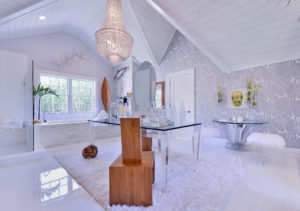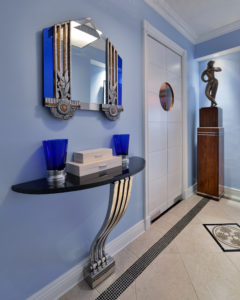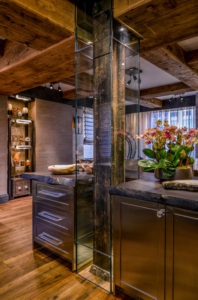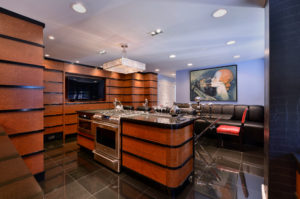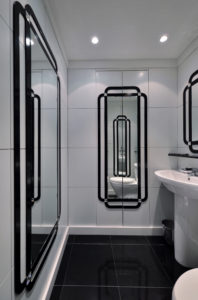Keith Baltimore, New York-based designer and founder of Baltimore Design Group, has redefined modern living with his emphasis on tactile organic materials and high-power glamour, to create sensorial experiences in the spaces he designs. He talks to Luxury Next about how he ventured into the world of design, his anthropological approach to design, and his best projects.
Keith Baltimore
Where did you study design? And what made you want to be an interior designer?
I was always interested in the built environment, curious about the structure and mechanics of the visual. At 8 years of age, I was constantly re-arranging my parents’ furniture and offering my mother advice about color schemes and pattern selection, much to her decorator’s chagrin. This was when I began my foray into interior design. As a teenager, living in New York City was so stimulating – there were fascinating things to look at: graffiti, building facades, patterns of shadows, textures, water-towers on rooftops. All these images excited my artistic sensibility, so by the time I went to university, my creative instinct was indelible. In my freshman year, in addition to the rigors of my academic curriculum, I took a sculpting class, and the professor was so impressed with my work that he became my mentor as I majored in design, fine art, and theater.
When and how did you establish your practice?
After leaving university, I worked at an interior design store as draftsman and associate designer. Then, in 1989, I decided to be on my own, and opened a small studio on Long Island, followed by my first retail shop a year later. I am so grateful for the loyal and discerning clientele that I have cultivated since my early beginnings. My business continues to flourish from recommendations, exposure at designer show-houses, and media coverage.
Glass and Crystal Lighting and Tables
How would you define your design philosophy? Could you explain it in terms of two of your interior design projects?
My approach is essentially anthropological; my first consideration while designing a room is to fully understand my client, their lifestyle, and their inspiration. If they have a treasured piece of furniture or artwork, I incorporate it into the functional visual that reflects their personality. Then I can translate these insights into a space that they will love to live in.
For instance, for clients living in a terraced NYC apartment overlooking Central Park and the infamous Dakota apartment building where John Lennon lived, I created an urban Zen oasis. I used a mélange of glass, live-edged wood, root brown granite, cement, rusticated beams, metals and other natural materials for the ultimate in industrial chic, emanating an ambiance of sophisticated comfort.
Another example is a client living in a spacious Manhattan apartment, who owns a stunning collection of Art Deco antiques, glass, mirrors, and wall art. By selecting a color scheme that complements these individual items, all the rooms flow naturally, while each precious piece stands out.
For a client who adores the Art Deco period, Keith set the stage right at the entry to the Manhattan apartment.
What marks your work – is it the use of technology? Is it an out of box thinking? Or is it something else?
I push the envelope, infusing my designs with cutting-edge technology. Additionally, one of my signature techniques is to add an element of surprise and drama or whimsy to complete a room. Many projects deal with trying to minimize or eliminate difficult features in a room. Inconveniently placed structural beams or support columns can be transformed into interesting features. For example, I recently encased a floor-to-ceiling beam in glittering glass. Instead of trying to ignore it, I give it a decorative presence. I am always embracing the hand I’m dealt.
Note the glass encased floor to ceiling beam that divides the kitchen from the dining area and living room.
You feel that you can see through it to the other areas without noticing the intrusive beam within.
How do you interpret your work in the context of the physical space, the environment, the cultural background of the city in which your design work is located?
I draw inspiration from everything around me, especially from my client’s vibe. As a lover and patron of the arts, museums, theater and galleries are sources where I find new ideas. Simply walking along city streets at home or abroad, even a small detail or image from another culture can inspire me to marry it with one of my projects. To connect with nature in the midst of the city, I use organic materials like the finest wood, stone, plants and crystals. No matter what I am doing or where I am, I look for both the new and the mundane, transforming them in my designs into the unusual and the fabulous.
Here Keith chose this rich highly lacquered Madrona wood sweeping around
the kitchen walls concealing the appliances, drawers, and storage spaces.
What projects proved to be a turning point in your career?
I built a luxury resort in the Caribbean, inside and out, including all the guestrooms, fine restaurant, the spa, and pool area.
Tell us about one project that was a big challenge.
I designed a hunting lodge in Colorado that was full of taxidermy. Hunting is not something I relate to.
What are the projects you are working on now?
Aside from many residential projects, I am working on a large condominium complex on Long Island.
What are the new trends in luxury design and interiors?
I love the hi-tech tactile luxury fabrics and cut velvets. There is an ease of living with materials and textiles that are cleanable, washable, durable, and comfortable, while you sit back and simply press buttons to automate your environment. Remote controls for window treatments, lighting, fireplaces, media, etc., are today’s feature of luxurious living.
Your interior design studio also works in the world of luxury furniture. What attracted you to luxury furniture?
I’m all about luxury and glamour, so I naturally gravitate to the finest that the industry has to offer for my discerning and upscale clients. Luxury furniture is incomparable when it comes to the quality of the materials and standards of workmanship, attention to details, and the refinement of the designs.
A surprise awaits inside a small bathroom – sparkling white wood doors
accented by black molding and Swarovski crystals conceal a bathtub.
What kind of role do you think contemporary interior design plays in shaping today’s cities?
Living in cities means maximizing space in a very utilitarian way, similar to the way airplanes and cruise ships plan for every square inch. Pre-planning of storage enhances the flow of functional tasks and conceals unattractive electrical equipment and household appliances. For example, my designs for drawers and closets are meticulously thought-out and customized; often I enhance the interiors for the sheer pleasure of the occupant, lining drawers in rich velvet and wallpapering inside closets.
Can you name a building you really admire, or one that inspires you?
The Chrysler Building, an Art Deco icon opened in 1930, really moves me as a dynamic expression of the early 1930s in America, a symbol of hope and renewal in spite of the Great Depression. It is fascinating that the automobile maker used design elements from their cars on the building itself. Conversely, Frank Gehry’s work today reflects the post-millennial era in much the same way that the Chrysler Building reflected the societal mindset of its day.


